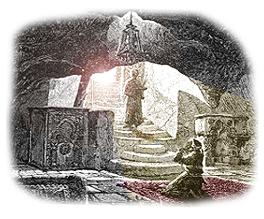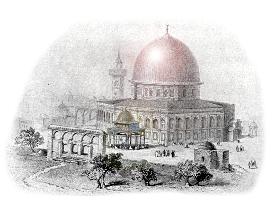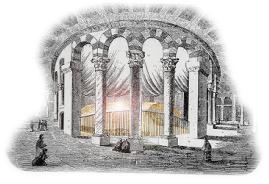|

The tannaitic term
even ha-shetiyah (Foundation Stone) was understood in two ways
during Talmudic times: "the stone (or rock) from which the world was
woven" and "the foundation stone." Both meanings are based on the belief
that the world was created from the stone located in the Holy of Holies
of the Temple in Jerusalem, thus forming the center of the world. This
concept is closely related to the image of Jerusalem and the Temple
as located at the "navel of the world." The Holy Ark was placed on this
rock, and during the Second Temple period, the high priest, upon entering
the Holy of Holies on Yom Kippur, placed the fire-pan on it. Muslim
tradition identifies the rock, over which was built the Dome of the
Rock, with the even ha-shetiyah.
The following are a few of the many midrashim and legends surrounding
the Foundation Stone:
The holy Zohar,
the principal work of the Kabbalist mystics, relates: "When the Holy
One, blessed be He, was about to create the world, He detached one precious
stone from underneath His throne of glory and plunged it into the abyss;
one end of it remained fastened therein, while the other end stood out
above. Out of the latter the world started, spreading itself to the
right and left and into all directions." That stone is called in Hebrew
even ha-shetiyah — the Foundation Stone.
Some of the wise men of Israel say that this stone was called shetiyah,
which in Hebrew also means "drinking," because beneath it is hidden
the source of all the springs and fountains from which the world drinks
its water.[1]
 There
is a Hebrew legend that the divine Name, YHWH, was inscribed on the
Foundation Stone. In the Book of Ecclesiastes it is said: "He has made
everything beautiful in its time; also He has set the world in their
heart, yet so that man cannot find out the work that God has done from
the beginning, even to the end." There
is a Hebrew legend that the divine Name, YHWH, was inscribed on the
Foundation Stone. In the Book of Ecclesiastes it is said: "He has made
everything beautiful in its time; also He has set the world in their
heart, yet so that man cannot find out the work that God has done from
the beginning, even to the end."
The Aramaic
translator adds: "This hints of the divine name on the Foundation Stone.
The divine Name was engraved on the Foundation Stone, and the Lord guarded
it in great secrecy, so as not to arouse the evil inclination in the
hearts of men, who would desire to know —
with its help — all that shall come to pass
in the end of time, until eternity."
According
to the rabbis, the Foundation Stone already played a role during the
patriarchal period. When Jacob woke from his dream at Bethel, he erected
a pillar to the Lord, using the stone which had been his pillow, and
then poured oil upon the top as a libation. This, they claimed, was
the Foundation Stone.
The Torah records of Jacob: "And he lighted upon a certain place." The
commentators note that he recognized in a vision that this was the future
site of the Temple, and he therefore named it Bethel, the House of God.
Many Christian pilgrims in the Middle Ages gave the name of Bethel to
the Temple site in Jerusalem, and believed this was the spot where the
patriarch Jacob rested from his journeys, dreamt his dream, and set
up this very Foundation Stone.
 At a later date, when Jonah the prophet was swallowed by the fish, he
had the privilege of seeing, among other things, the base of the Foundation
Stone. There was a certain pearl embedded in the bowels of the fish.
This pearl gave forth light for Jonah — as
does the sun at noontime, and illumined for him all that is in the sea
and the abyss.... And it showed him the Foundation Stone set in the
abyss below the Temple of the Lord.
At a later date, when Jonah the prophet was swallowed by the fish, he
had the privilege of seeing, among other things, the base of the Foundation
Stone. There was a certain pearl embedded in the bowels of the fish.
This pearl gave forth light for Jonah — as
does the sun at noontime, and illumined for him all that is in the sea
and the abyss.... And it showed him the Foundation Stone set in the
abyss below the Temple of the Lord.
The fish said to Jonah: "Behold, you are now below the Lord's Temple.
Pray, and you will be answered." And Jonah began to pray before the
Holy One blessed by He, whereupon the Lord signaled to the fish, and
it threw Jonah upon the shore."
The home of the
Foundation Stone was the Holy of Holies in the Temple in Jerusalem.
According to legend, when King David dug the foundation for the Temple,
he found a stone resting on the mouth of the abyss with the divine Name
on it. He put this stone into the Holy of Holies in the Temple. The
sages of Israel began to fear lest some young men learn the divine Name
and destroy the world. To prevent this, they placed two brazen lions
on iron pillars by the door of the Holy of Holies, one on the right
and the other on the left. If anyone entered and learned the divine
Name, these lions would roar at him when he came out, so that through
terror and fright, the Name would be utterly driven out of his mind
and forgotten.[2]
 From
this stone, situated at the center of the world, emanated the divine
blessing which was bestowed upon all of Israel. With the destruction
of the Temple, this benediction was lost, to the lasting sorrow of Israel.
There is a legend that relates the Hebrew word shetiyah to the
Aramaic word, shetiyah, which means "weaving." Accordingly, a
custom grew up among Jewish women to refrain from weaving during the
nine days of mourning, from the first day of the month of Av to the
ninth day (Tish'ah be-Av), which commemorates the destruction of the
Temple. They believed that there would be no blessing on their work
in these sad days. The ancients found a hint of this in the saying of
the psalmist: "When the foundations are destroyed, What have the righteous
wrought?" The sages interpret this to mean: "Since the Temple is destroyed,
what have the righteous achieved?"[3] From
this stone, situated at the center of the world, emanated the divine
blessing which was bestowed upon all of Israel. With the destruction
of the Temple, this benediction was lost, to the lasting sorrow of Israel.
There is a legend that relates the Hebrew word shetiyah to the
Aramaic word, shetiyah, which means "weaving." Accordingly, a
custom grew up among Jewish women to refrain from weaving during the
nine days of mourning, from the first day of the month of Av to the
ninth day (Tish'ah be-Av), which commemorates the destruction of the
Temple. They believed that there would be no blessing on their work
in these sad days. The ancients found a hint of this in the saying of
the psalmist: "When the foundations are destroyed, What have the righteous
wrought?" The sages interpret this to mean: "Since the Temple is destroyed,
what have the righteous achieved?"[3]
The Zohar
relates that from this spot all the world is blessed. Groups of angels
and cherubim hover above the Foundation Stone: "At the time of the sunrise,
[they] stand in this place, raise their wings upward and spread them,
and the sound of the melody of their wings is heard." And what song
did they sing at this hour?
"They that
trust in the Lord are as Mount Zion,
which cannot be moved but abides forever.
As the mountains are round about Jerusalem
So the Lord is round about His people
From this time forth and for ever."
And the stars and the planets
in the heavens joined in the song. The angels above, and Israel below, all hold
fast to the stone, and it rises in heaven and rests among the righteous. And the
Holy One, blessed be He, comes to frolic with them in the Garden of Eden."[4]
|
[1]
Zohar II, 1867, p. 222; III, p. 131. [Back]
[2] Avot de-Rabbi Nathan (1) 36. Pesikta
de-Rab Kahana 148a. Ecclesiastes 3:11. The Aramaic translation
(Targum Yerushalmi) to Exodus 28:30. [Back]
[3] Yerushalmi, Pesahim 4:1; Ta'anit 1:6,
Bavli, Sanhedrin 26b. Psalms 1:3. J. Caro, Shulkhan Arukh:
Orah Haim 551:8. [Back]
[4] Zohar I, 1895, p. 231b. Psalms 125:1-2. [Back]
|
|
From:
Legends of Jerusalem. The Sacred Land: Volume 1, ed. Zev Vilnay.
Jewish Publication Society, 1973.
|
|